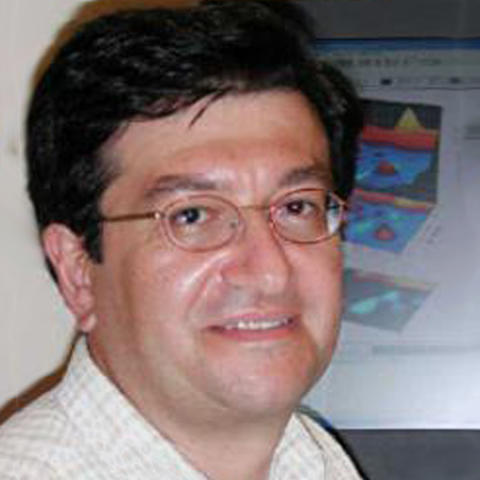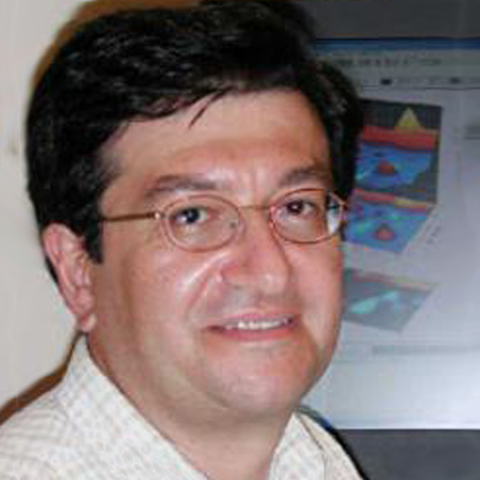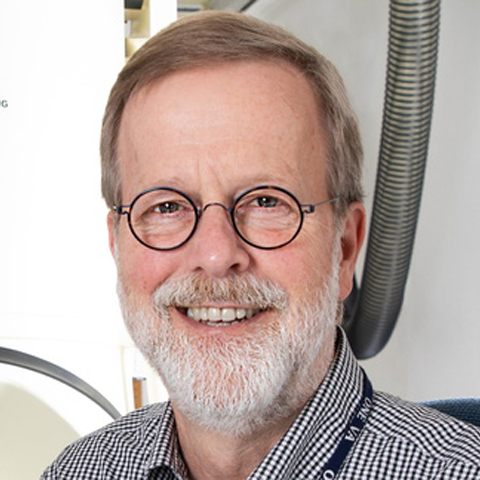Faculty



Research Summary
Computations in the Motor Cortex: Cortical Microcircuits, Functional Columns, and Motor Control Signals Cortical processing is mediated through the short-range (local microcircuits) and the long-range (interaction involving distinct microcircuits) connections between excitatory and inhibitory neurons distributed across distinct cortical layers. My current research interests are focused on two problems. i. Whether do these spatially structured intrinsic connections induce functional modularization of the motor cortex (e.g., segregation of neurons with coherent properties into columns), and how do they shape the computation of neural motor control signals? ii. How does one translate neural signals extracted from the motor cortex into signals appropriate for "intelligent" motor control of prosthetic devices (e.g., multijoint robotic arm)? To investigate these problems we use the methods of neural network modeling, and carry out very large-scale simulations on high-performance massively parallel supercomputers.
Contact
Address
6-145 Jackson Hall321 Church St SE
Minneapolis, MN 55455


Bio
Alfonso Araque is a professor in the Department of Neuroscience. His research interests focus on the mechanisms, properties and physiological consequences of the communication between neurons and astrocytes. His research seeks to understand how the communication between neurons and astrocytes affects physiological and pathological aspects of brain function. While most studies on drug addiction are focused on neuronal mechanisms, his team aims to elucidate the involvement of astrocytes in behaviors associated with reward signaling and psychostimulant drugs, which may reveal astrocytes as potential targets for treatment of motivation disorders such as drug addiction.
Research Summary
Astrocyte-neuron signaling Research of my group focuses on the mechanisms and physiological consequences of the astrocyte-neuron signaling, aiming to understand its role in physiological and pathological aspects of synaptic physiology and brain function. Astrocytes, classically considered as supportive cells for neurons without a direct role in brain information processing, are emerging as relevant elements in brain physiology through their ability to regulate neuronal and synaptic activity. We are studying how astrocytes respond to neuronal activity, how they control neuronal activity and synaptic transmission and plasticity, and how they are involved in neural network function.My previous work provided the first demonstration of regulation of synaptic transmission by astrocytes and the definition of the Tripartite Synapse concept, which represents a novel view of synaptic physiology. According to this concept, astrocytes are integral functional elements of synapses by exchanging information signals with neurons. My recent contributions include: the demonstration that astrocytes display integrative properties for synaptic information processing, the demonstration of astrocyte regulation of synaptic transmission at single synapses, the first description of astrocyte involvement in endocannabinoid signaling and its consequences on synaptic transmission; the first design of artificial AstroNeuronal networks -a novel concept in artificial intelligence-, and the demonstration that artificial astrocytes improve network performance; the demonstration of astrocyte-mediated synaptic plasticity in vivo; and the demonstration of astrocyte-neuron signaling in human brain tissue.We are currently investigating the cellular mechanisms and physio-pathological consequences of astrocyte-neuron interactions in different brain areas to test the working hypothesis that brain function results from the operation of AstroNeuronal networks established by the coordinated activity of astrocytes and neurons. We are also interested in deciphering the contribution of the altered function of Tripartite Synapses and AstroNeuronal networks to brain diseases.


Research Summary
Motor Learning and Adaptation The primary interest of my laboratory is in motor learning in the most general sense. We are concerned with how we learn regularities in our immediate environment and how this learning is reflected in our actions and behavior. To address these issues, we use psychophysical studies, functional imaging in humans, and direct neural recording from areas in frontal cortex in non-human primates.Specific Projects: Motor learning of new dynamic environments. We have been examining the neural control of adaptation and learning in specific physical environments, usually in the form of state dependent force fields. The work focuses on the learning, storage, and consolidation of and interference with internal models of motor behavior. Neural basis and mechanisms of motor learning in probabilistic environments. We examine how subjects use probabilistic information and predictability in their immediate environment to shape their actions and behavior. The learning behaviors we study range from complex probabilistic patterns to deterministic sequences. Neural control and learning of serial order. The concept of serial order is fundamental to much of our behavior from basic motor function to language production. We have examined the neural basis of serial order and sequence production in well practiced motor behaviors and also during the learning of these behaviors through trial and error. The modulation of action through reward. Much of our behavior is shaped by rewards (both external and internal); we have recently begun to examine how reward (and punishment) influences motor learning. Disruption of the reward-action system may be a fundamental problem in some disease conditions such as Parkinsons disease. Neural control of goals versus actions. In everyday life, we typically decide on goals and then perform the actions to achieve them. We are now studying the system in prefrontal cortex that deals with goals and actions in an effort to understand how these interrelated factors are controlled.


Research Summary
Intelligent behavior Intelligent behavior in higher primates and humans is often characterized by the ability to act on the basis of abstract information that is generated internally rather than strictly reflecting the sensory input. Examples include actions that are directed toward goals, based on rules, or informed by generalized principles. By changing goals, rules, or principles, the brain can flexibly process the same sensory input to produce different, context-appropriate actions, a capability referred to as executive control. In order to better understand executive control as a biological process, we record the electrical activity of individual neurons (typically 20-30 neurons at a time) in different cortical areas as the brain applies different rules to compute context-dependent information, relating the information coded by neural activity to the computational flexibility required. Two independent projects sharing this general approach are ongoing in our laboratory.The first project investigates the network basis of executive control over spatial cognitive processing in a task that requires that the brain place the same visual stimulus into different spatial categories on the basis of a changing rule. We have compared the spatial information coded by neural activity recorded concurrently in the prefrontal and posterior parietal cortex; two cortical areas connected by direct axonal projections that are jointly recruited during spatial cognitive processing. Our findings thus far indicate that executive control is a distributed process, in the sense that activity patterns coding the spatial category of a stimulus, as a function of the rule applied, can be found to exist within both parietal and prefrontal cortex. However, we are finding that the rule exerts an earlier and stronger influence on neural signals coding categories in prefrontal cortex, suggesting this area may play a particularly large or early role in the computational flexibility that underlies executive control.The second project seeks to better understand how neuronal information processing related to executive control is disrupted in schizophrenia. Converging lines of pharmacological, anatomical, and genetic evidence suggest that schizophrenia is the product of a disease process that disrupts neurotransmission at the NMDA glutamate receptor. We are currently developing experiments to investigate how blocking this receptor degrades the ability of prefrontal neurons to generate rule-dependent patterns of activity, leading to behavioral errors in executive control tasks that are characteristic of the disease. Our hope is that this work will extend our understanding of how schizophrenia disrupts information processing at the level of single prefrontal neurons to produce cognitive deficits.
Contact
Address
6-145 Jackson Hall321 Church Street SE
Minneapolis, MN 55455


Bio
Dr. Chen is an Assistant Professor in the Department of Neuroscience. Her research investigates the development of nerve projections that regulate reward and motivation. Miswiring of these neural circuits can negatively impact self-control and addictive behaviors. Dr. Chen's lab utilizes a combination of molecular, genetic, and imaging approaches.
Research Summary
Molecular mechanism of neural development (neuronal migration, axon guidance, and synapse formation), pathogenesis of neurological disorders (agenesis of corpus callosum, split brain syndrome), and regulation of cell signaling.
Contact
Address
2001 6th St SEMinneapolis, MN 55455-3007


Research Summary
Glial Cells in Neurodegenerative Disease Our lab aims to understand how different brain cells and their interactions influence the onset and progression of neurodegenerative diseases. In particular we study the involvement of astrocytes and microglia in the pathogenesis of inherited neurodegenerative disease Spinocerebellar ataxia type 1(SCA1). SCA1 belongs to the family of polyglutamine diseases, that include Huntington's disease as it is caused by the expansion of CAG repeat (encoding for glutamine) in the coding region of Ataxin-1 gene. To do this we are using mouse genetics, cell and molecular biology techniques, mouse behavior, confocal microscopy and flow cytometry. The ultimate goal is to increase knowledge of the cellular and molecular pathways that underlie pathology of neurodegenerative disorders and open new avenues for therapeutic approaches. Another main focus of the lab is to train the next generations of scientists by creating the supportive environment that is conductive to learning, creating and testing new ideas.


Research Summary
Mitochondrial permeability
Neuroscience Research:
We have examined the involvement of the mitochondrial permeability transition in isolated CNS mitochondria from normal and Huntington's Disease model mice. At the systems level, we are currently examining metabolite changes in brains of Huntington's Disease model mice and how these metabolite changes can be used both as biomarkers for disease progression and to provide insight into mechanisms of disease progression.
A new project is investigating how certain classes of drugs might alter synaptic vesicle availability or cycling as a means of limiting high frequency activity in epilepsy.
Research in Science Teaching:
The field of neuroscience probes the cellular, molecular and circuit properties contributing to learning and memory, processes that should influence teachers' classroom strategies and practices. Providing professional development for postbaccalaureate teachers into the biological basis of learning and memory applies the new knowledge generated in my field towards solving a pressing societal need, improving K-12 science education. As a research scientist, communicating this knowledge to teacher audiences is a part of translational research. BrainU is a professional development program for K-12 science teachers interested in understanding the brain and its relevance to education (www.brainu.org). BrainU was created in response to requests from teachers to learn more neuroscience than could be covered in one-hour classroom visits. My goals for the BrainU program are to engage teachers both in teaching about and applying neuroscience to their classroom practices and to motivate teachers and their students to learn more about themselves and the pursuit of science. Our research goals are to probe how learning about the nervous system motivates teachers and students to teach, learn and do science in their classrooms.
Contact
Address
6-145 Jac H321 Church St SE
Minneapolis, MN 55455


Contact
Address
420 Washington Ave SEMinneapolis, MN 55455-0372


Research Summary
Neurophysiology of cerebellum and motor cortex. Our laboratory is trying to understand how single neurons and populations of neurons encode the information needed to plan and execute limb movements. Our goal is to decipher how the brain represents different movement parameters and then uses this information to control movements. We are investigating both kinematic and dynamic movement parameters, recording the activity of neurons in the cerebellum and cerebral cortex in primates during motor behaviors. A variety of movements are studied, including reaching to targets in space, tracking moving targets, the learning of new visuomotor relations, and hand movements. Using analytical and statistical techniques, we sort out how information about movement parameters is embedded in the neuronal discharge.At a higher level of integration, we are interested in how information in the brain is represented spatially and temporally in populations of neurons. In the cerebellum we are using flavoprotein fluorescence and Ca++ dyes to visualize neural activity. Using epifluorescence and multi-photon imaging, we are able to construct detailed spatial and temporal maps of the neuronal activity in the cerebellar cortex. One major question is to understand the spatial patterns of activity generated during behavior. We are also using optical imaging to examine the abnormalities in the cerebellar cortex in the spinocerebellar and episodic ataxias.
Contact
Address
421 Lion Res2001 6th St SE
Minneapolis, MN 55455


Grants and Patents
Selected Grants
Contact
Address
123 Sn H1475 Gortner Ave
St Paul, MN 55108


Research Summary
Predictors of PTSD onset and recovery including brain function, genetics, and spirituality. The primary goal of the research at the Brain Sciences Center is to elucidate the dynamic mechanisms of the working brain in health and disease. The neuroscientists at the Brain Sciences Center are working to unlock the mysteries of debilitating neurological diseases, disorders, and addictions. With today's technology, researchers are able to view these dynamic processes of the working brain, and take the first steps toward understanding the mechanisms which may lead to treatment and prevention to help the millions suffering from brain afflictions.

